Spatio-Temporal Evolution of Loading and Deformation of Surface Gas Pipelines for High-Intensity Coalbed Mining and Its Integrity Prediction Methodology
Abstract
1. Introduction
2. Engineering Background
3. Integrity Prediction Method of Gas Pipeline in Mining Subsidence Area
3.1. Elastic Deformation Limit of Pipeline
3.2. Pipeline Safety Protection Methods
3.3. Analysis of Theoretical Calculation Results
4. Materials and Methods
4.1. Modeling and Methodology Design
4.2. Model Validation
5. Analysis and Discussion of Results
5.1. Surface and Pipeline Subsidence Characteristics
5.2. Pipeline Stress Analysis
5.3. Deformation Analysis of Main Load Direction of Pipeline
5.4. Discussion
6. Conclusions
Author Contributions
Funding
Data Availability Statement
Conflicts of Interest
References
- Yuan, L. Scientific problem and countermeasure for precision mining of coal and associated resources. J. China Coal Soc. 2019, 44, 1–9. [Google Scholar]
- Yuan, L.; Zhang, T.; Zhao, Y.X.; Ren, B.; Hao, X.J.; Xu, J. Precise coordinated mining of coal and associated resources: A case of environmental coordinated mining of coal and associated rare metal in Ordos basin. J. China Univ. Min. Technol. 2017, 46, 449–459. [Google Scholar]
- Wang, T.; Sun, J.; Lin, Z.Y.; Fang, H.M.; Wang, Y.; Liu, Y.F. Coordinated Exploration Model and its Application to Coal and Coal-associated Deposits in Coal Basins of China. Acta Geol. Sin. Engl. Ed. 2021, 95, 1346–1356. [Google Scholar] [CrossRef]
- Hao, D.Y.; Zhang, T.; Yang, Y.B.; Ren, J.M. Study on the disturbance characteristics and control strategies of coordinated exploitation of superimposed resources of coal and oil-type gas in Ordos Basin. Energy Sci. Eng. 2023, 11, 3964–3978. [Google Scholar] [CrossRef]
- Liang, S.; Elsworth, D.; Li, X.H.; Fu, X.H.; Yang, D.; Yao, Q.L.; Wang, Y. Dynamic impacts on the survivability of shale gas wells piercing longwall panels. J. Nat. Gas Sci. Eng. 2015, 26, 1130–1147. [Google Scholar] [CrossRef]
- Liang, S.; Elsworth, D.; Li, X.H.; Fu, X.H.; Sun, B.Y.; Yao, Q.L. Key strata characteristics controlling the integrity of deep wells in longwall mining areas. Int. J. Coal Geol. 2017, 172, 31–42. [Google Scholar] [CrossRef]
- Liang, S.; Elsworth, D.; Fu, X.H.; Li, X.H.; Yao, Q.L. Influence of Stratigraphic Conditions on the Deformation Characteristics of Oil/Gas Wells Piercing Longwall Pillars and Mining Optimization. Energies 2017, 10, 775. [Google Scholar] [CrossRef]
- Liang, S.; Elsworth, D.; Li, X.H.; Yang, D. Topographic influence on stability for gas wells penetrating longwall mining areas. Int. J. Coal Geol. 2014, 132, 23–36. [Google Scholar] [CrossRef]
- Fu, D.X.; Deng, B.; Yang, M.H.; Zhen, B.B. Analytical solution of overlying pipe deformation caused by tunnel excavation based on Pasternak foundation model. Sci. Rep. 2023, 13, 921. [Google Scholar] [CrossRef]
- Liu, M.; Ortega, R. Assessment of Impact to Buried Pipelines due to Tunneling-Induced Settlement. J. Pipeline Syst. Eng. Pract. 2023, 14, 04023020. [Google Scholar] [CrossRef]
- Chen, F.Q.; Fang, S.Q.; Lin, L.B. Mechanical Analyses of Underground Pipelines Subjected to Ground Subsidence Considering Soil-Arching Effect. J. Pipeline Syst. Eng. Pract. 2023, 14, 04022076. [Google Scholar] [CrossRef]
- Jiang, Q.; Guo, G.L.; Li, H.Z.; Wei, T.; Yuan, Y.F.; Jiang, C.M. Investigation of coordinated development of coal mining and pipeline protection under boundary effect of thick unconsolidated layer. Bull. Eng. Geol. Environ. 2022, 81, 136. [Google Scholar] [CrossRef]
- Ma, W.J.; Wang, B.L.; Wang, X.; Zhou, S.H.; Wang, B.L. Soil Layer Disturbance Caused by Pipe Jacking: Measurement and Simulation of a Case Study. Ksce J. Civ. Eng. 2021, 25, 1467–1478. [Google Scholar] [CrossRef]
- Orynyak, I.; Yaskovets, Z.; Mazuryk, R. Novel Numerical Approach to Analysis of Axial Stress Accumulation in Pipelines Subjected to Mine Subsidence. J. Pipeline Syst. Eng. Pract. 2019, 10, 04019026. [Google Scholar] [CrossRef]
- Oswell, J.M.; Hart, J.; Zulfiqar, N. Effect of Geotechnical Parameter Variability on Soil-Pipeline Interaction. J. Pipeline Syst. Eng. Pract. 2019, 10, 04019028. [Google Scholar] [CrossRef]
- Wu, Y.; You, X.; Zha, S.X. Mechanical behavior analysis of buried polyethylene pipe under land subsidence. Eng. Fail. Anal. 2020, 108, 104351. [Google Scholar] [CrossRef]
- Zhang, J.; Liang, Z.; Han, C.J. Numerical Modeling of Mechanical Behavior for Buried Steel Pipelines Crossing Subsidence Strata. PLoS ONE 2015, 10, e0130459. [Google Scholar] [CrossRef][Green Version]
- Zhang, J.; Xie, R. Numerical Analysis of Mechanical Behavior of Buried Pipes in Subsidence Area Caused by Underground Mining. J. Press. Vessel. Technol. Trans. Asme 2019, 141, 021703. [Google Scholar] [CrossRef]
- Zhang, J.; Xie, R. Mechanical behavior analysis of suspended pipelines caused by ground subsidence. J. Pipeline Syst. Eng. Pract. 2021, 12, 04021030. [Google Scholar] [CrossRef]
- Gu, W.B.; Wu, K.; Tong, L.Y.; Liu, S.Y. Study of Deflection of Buried HDPE Corrugated Pipeline under the Uneven Settlement of Soil. KSCE J. Civ. Eng. 2021, 26, 221–235. [Google Scholar] [CrossRef]
- Zhang, Y.; Hou, S.H.; Lin, L.; Lou, Y.H.; Zhou, Y. Experimental study on the mechanical behavior of buried steel pipeline subjected to the local subsidence. Int. J. Press. Vessel. Pip. 2023, 206, 105037. [Google Scholar] [CrossRef]
- Wang, W.; Ren, J.D.; Wang, F.B.; Dong, M.; Luo, Y.; Miao, C.G. Study on the Mining Mode of “Gas Corridor” in Erdos Basin. Met. Mine 2019, 10, 23–31. [Google Scholar]
- Ren, J.D.; Zhao, Y.X.; Sun, Z.B.; Wang, W.; Liu, S.M. Investigation on protective coal pillar optimization and multi-parameter evolution characteristics of buried pipeline in gas-coal superposition area. Rock Soil Mech. 2023, 44, 2679–2695. [Google Scholar]
- Song, Y.X.; Peng, J.B.; Wang, Z.J.; Li, X.; Zhao, X.K. Test study on mechanical characteristics of aeolian sand in MU US Desert. J. Eng. Geol. 2010, 18, 894–899. [Google Scholar]
- Guo, W.B.; Zhao, G.B.; Lou, G.Z.; Wang, S.R. Height of fractured zone inside overlying strata under high-intensity mining in China. Int. J. Min. Sci. Technol. 2019, 29, 45–49. [Google Scholar] [CrossRef]
- Guo, W.B.; Zhao, G.B.; Lou, G.Z.; Wang, S.R. A New Method of Predicting the Height of the Fractured Water-Conducting Zone Due to High-Intensity Longwall Coal Mining in China. Rock Mech. Rock Eng. 2019, 52, 2789–2802. [Google Scholar] [CrossRef]
- SY/T 0330-2004; Recommend Practice for Movement of in-Service Pipeline. Petroleum Industry Press: Beijing, China, 2004.
- Ren, J.D.; Zhao, Y.X.; Wang, W.; Guo, J.H.; Sun, Z.B.; Liu, S.M. Optimal Design of a Protective Coal Pillar with a Buried Pipeline in a Thick Loose Layer in Western China: Methodology and Case Study. Rock Mech. Rock Eng. 2023, 56, 2879–2896. [Google Scholar] [CrossRef]
- Zhao, B.; Zhang, H.L.; Wang, Y.; Zhou, Y.T.; Zhang, J.X. Mechanical Behavior of Gas-Transmission Pipeline in a Goaf. Processes 2023, 11, 1022. [Google Scholar] [CrossRef]
- Yu, C.; Han, C.J.; Xie, R.; Wang, L. Mechanical behavior analysis of buried pipeline under stratum settlement caused by underground mining. Int. J. Press. Vessel. Pip. 2021, 188, 104212. [Google Scholar] [CrossRef]
- Zhang, J.; Liang, Z.; Han, C.J. Mechanical behaviour analysis of buried pressure pipeline crossing ground settlement zone. Int. J. Pavement Eng. 2017, 18, 608–621. [Google Scholar] [CrossRef]
- GB/T 9711-2017; Petroleum and Natural Gas Industries Steel Pipe for Pipeline Transportation Systems. General Administration of Quality Supervision, Inspection and Quarantine of the People’s Republic of China; Standardization Administration of the People’s Republic of China: Beijing, China, 2017.
- Zhou, M.; Du, Y.J.; Wang, F.; You, Q.; Dong, D.D. Mechanical response of buried HDPE pipes subjected to localized land subsidence. Chin. J. Rock Mech. Eng. 2017, 36, 4177–4187. [Google Scholar]
- Li, H.J.; Zhu, H.H.; Zhu, B.; Wu, H.Y.; Liu, Z.Y.; Shi, B. Model tests on settlement of buried pipeline based on fiber optic monitoring. Chin. J. Rock Mech. Eng. 2020, 39, 3645–3654. [Google Scholar]
- Ren, J.D.; Zhao, Y.X.; Sun, Z.B.; Liu, S.M.; Wang, W. Study on time series rule of buried pipe failure under high-intensity coal mining in a gas-coal overlapping area. Coal Sci. Technol. 2023, 56, 2879–2896. [Google Scholar]

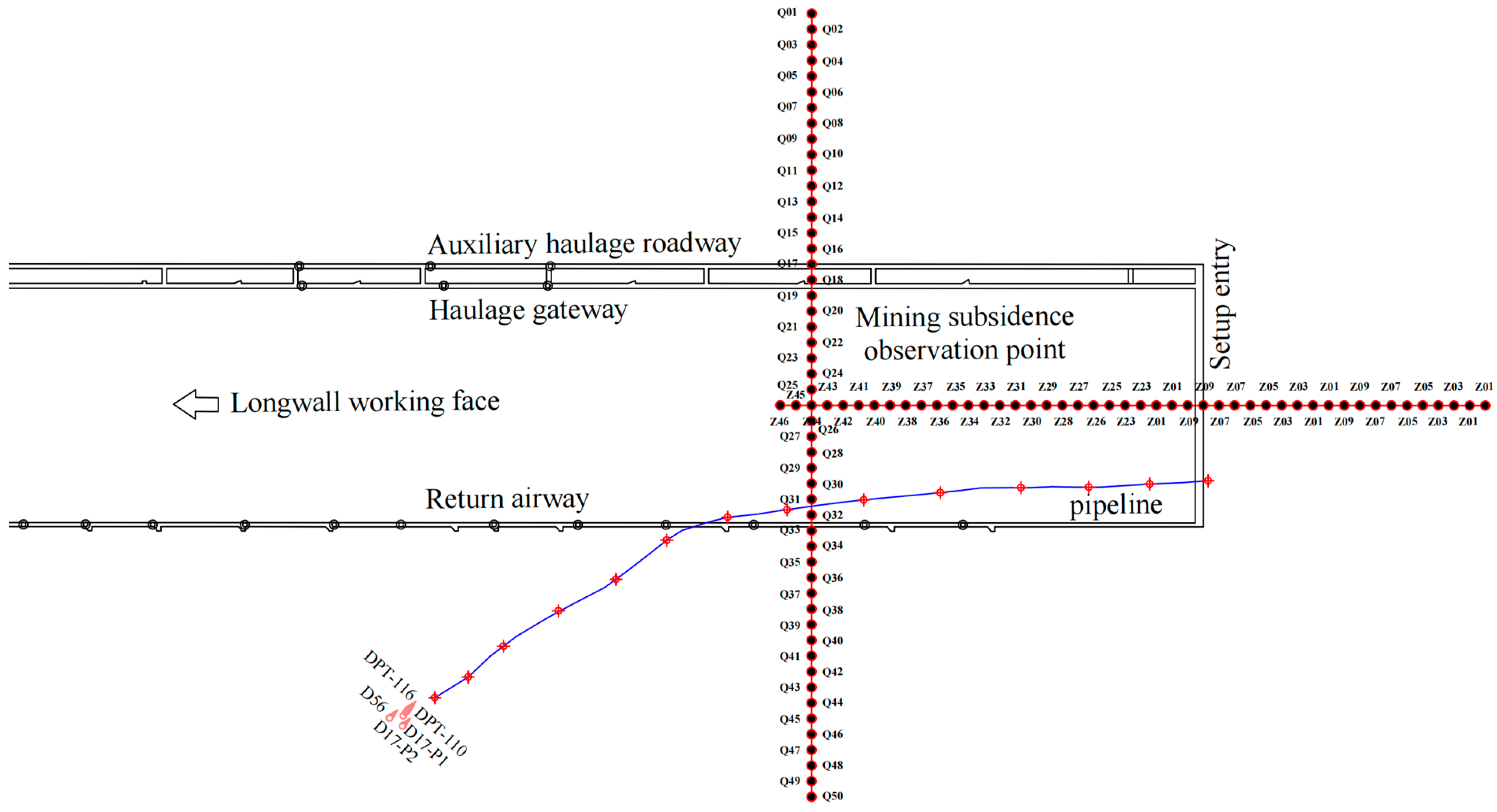
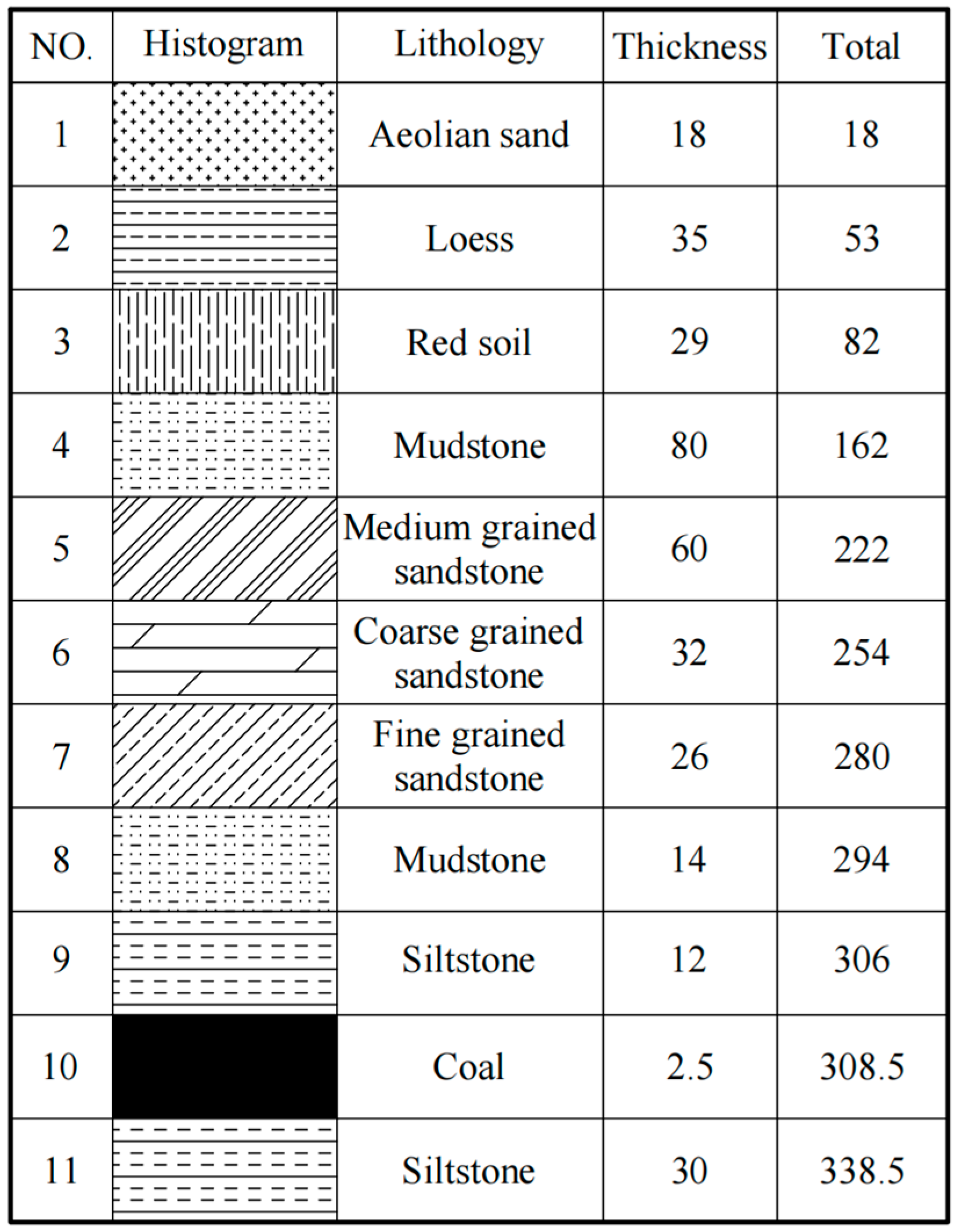





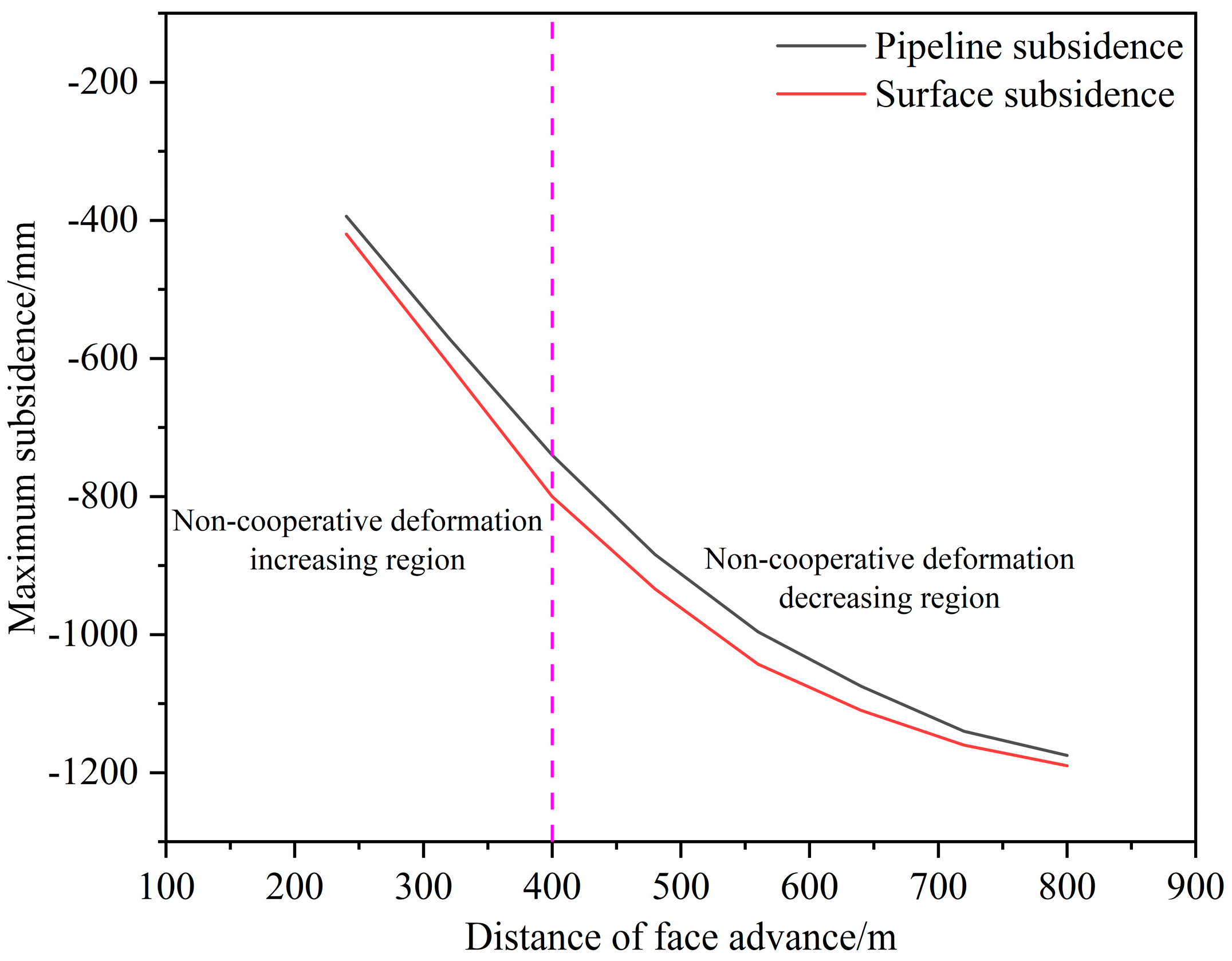
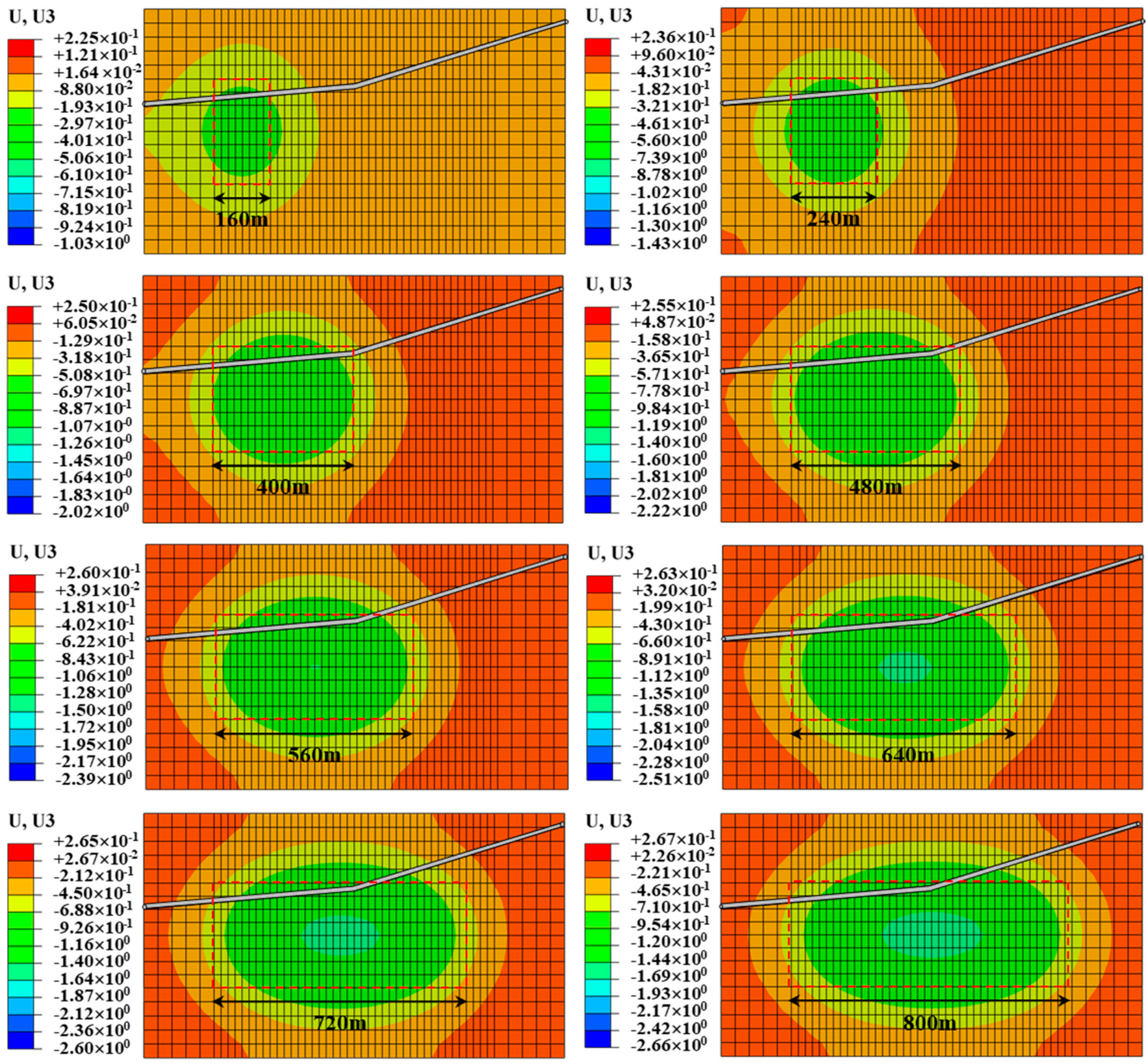
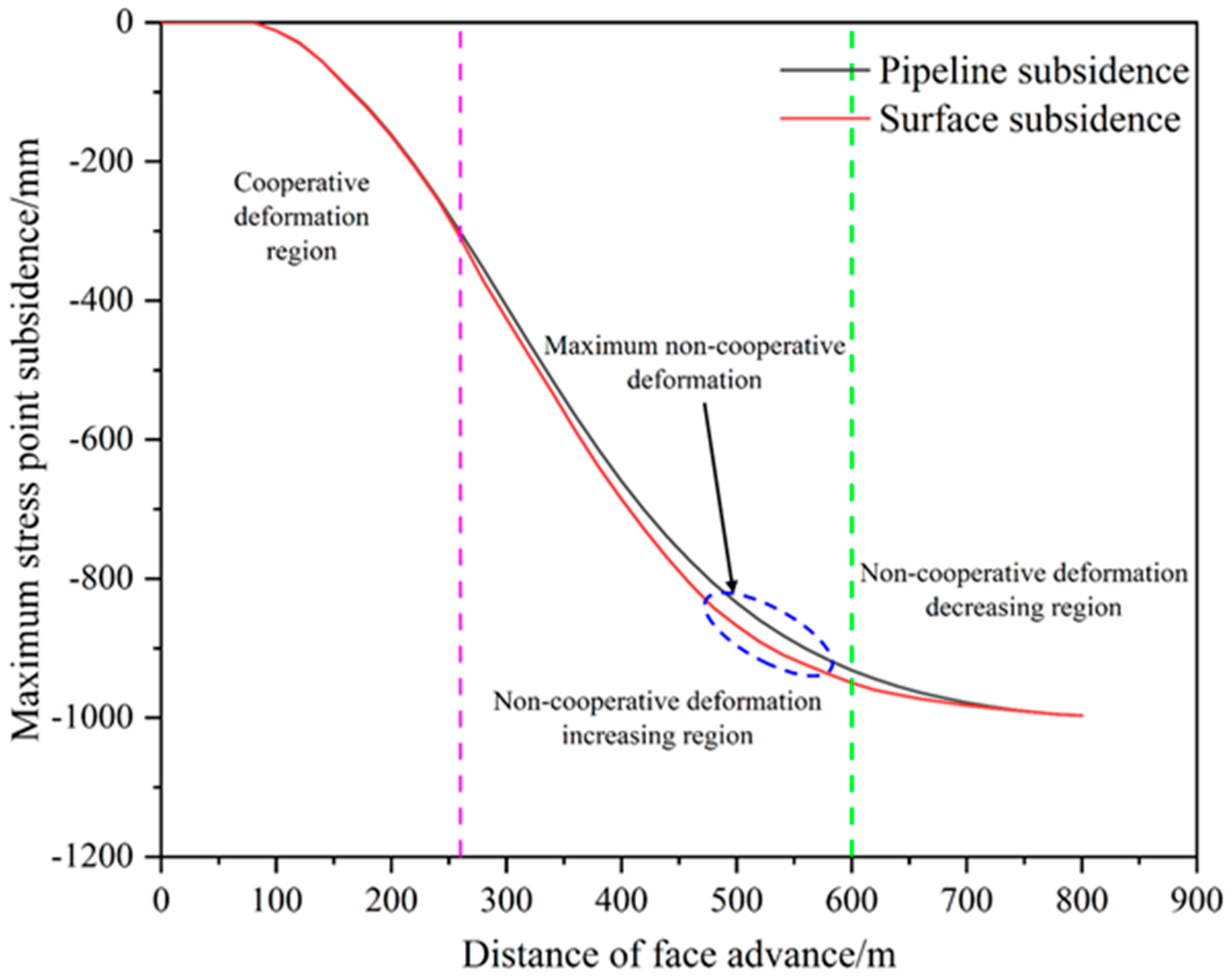
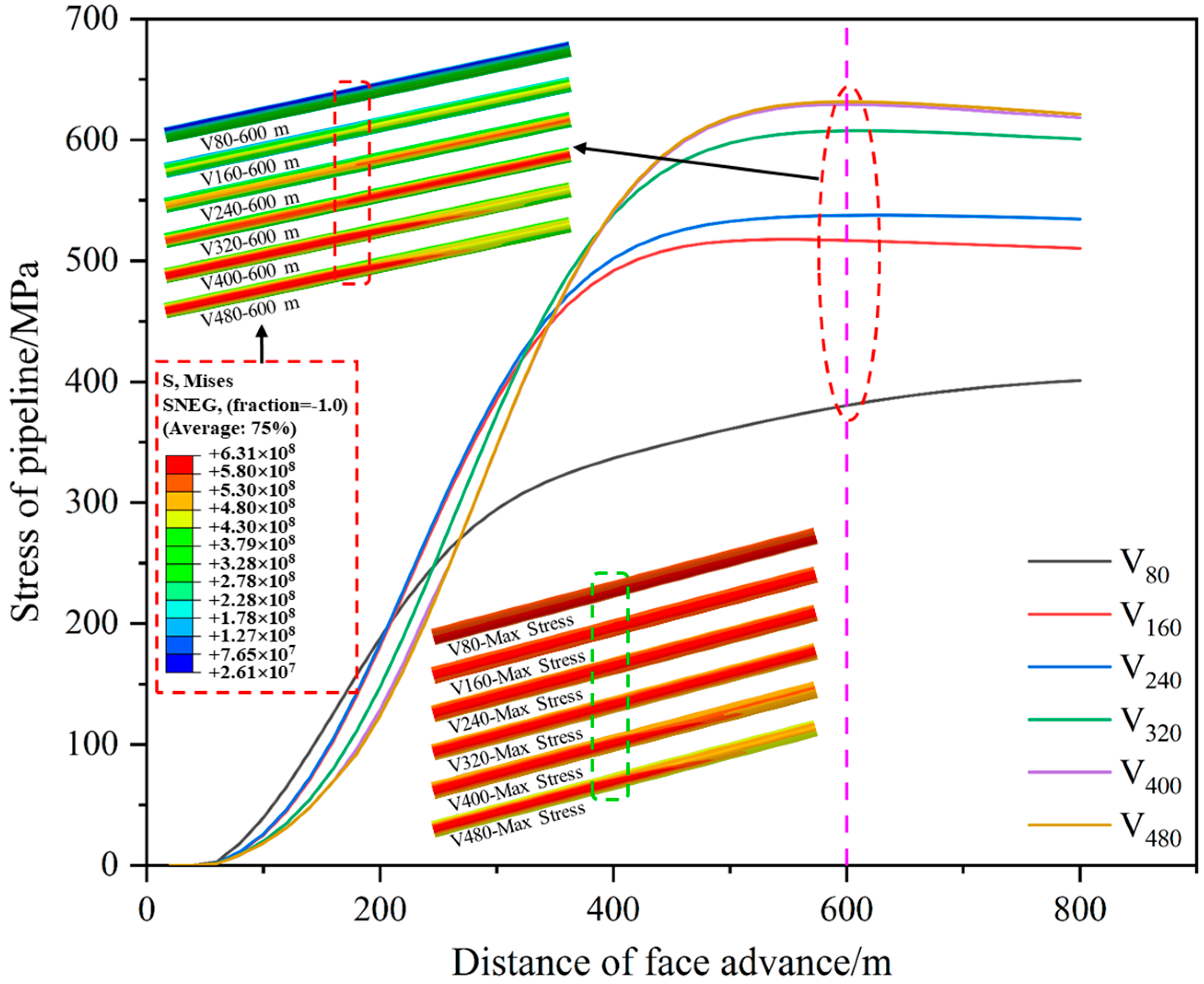
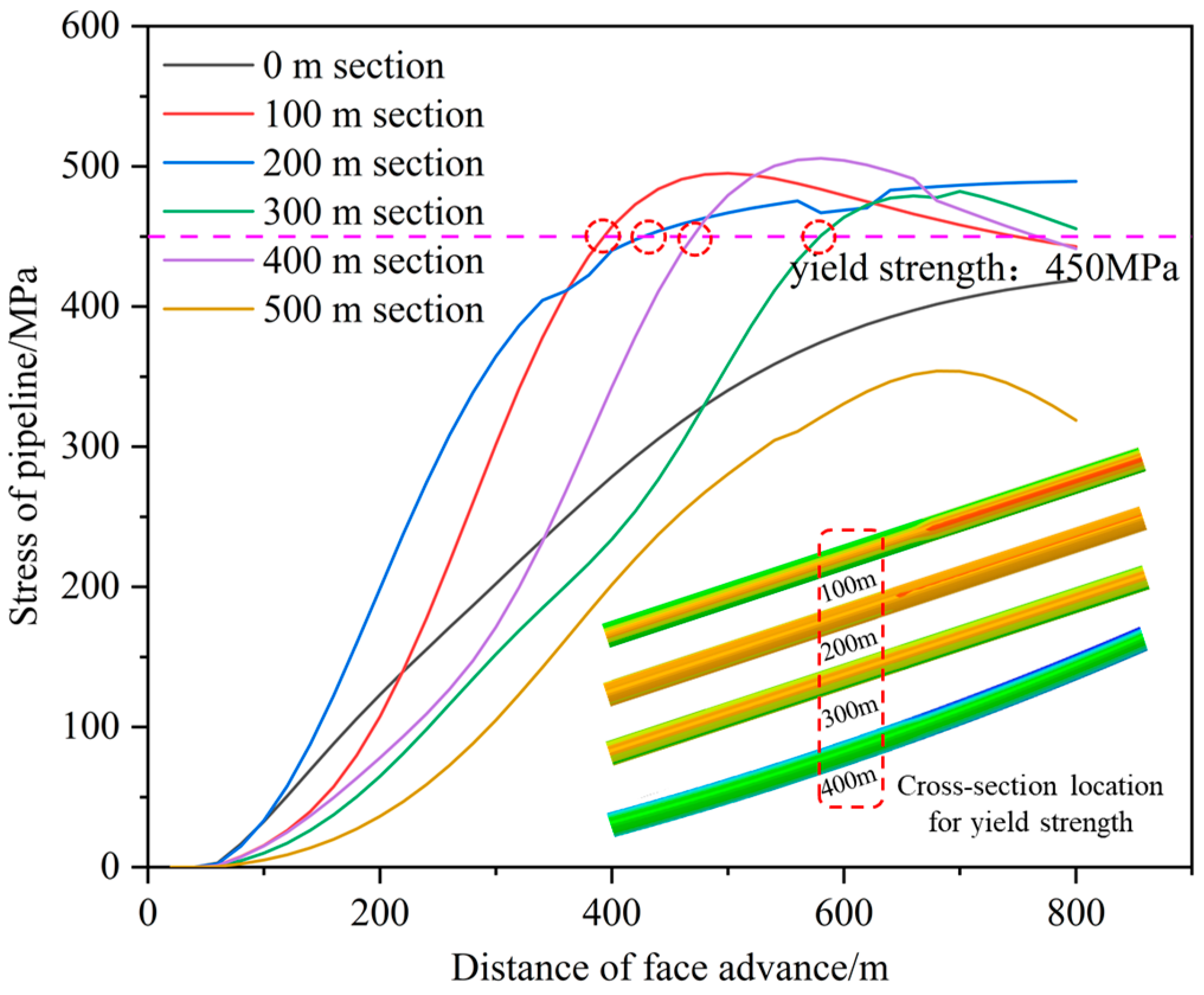
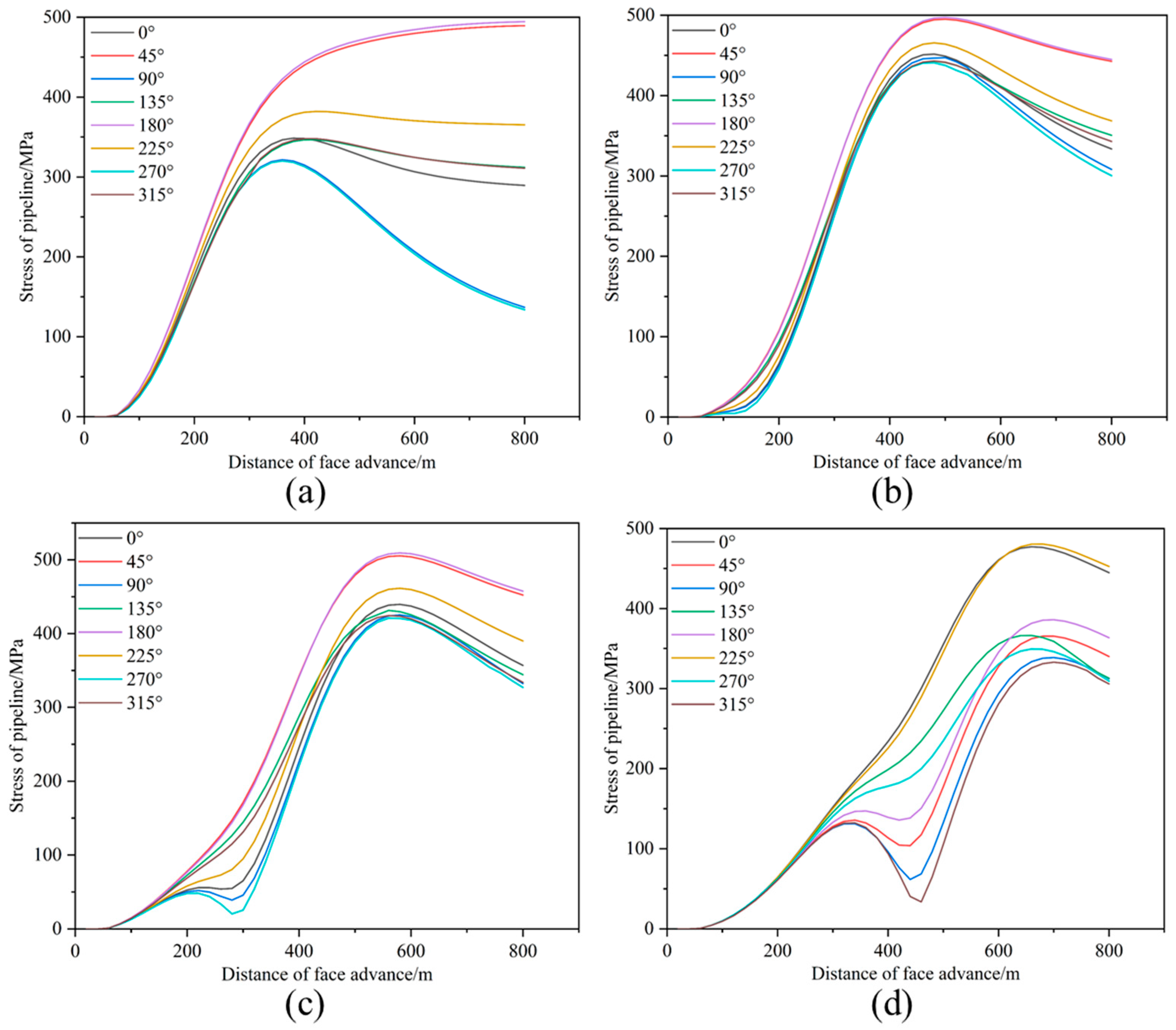

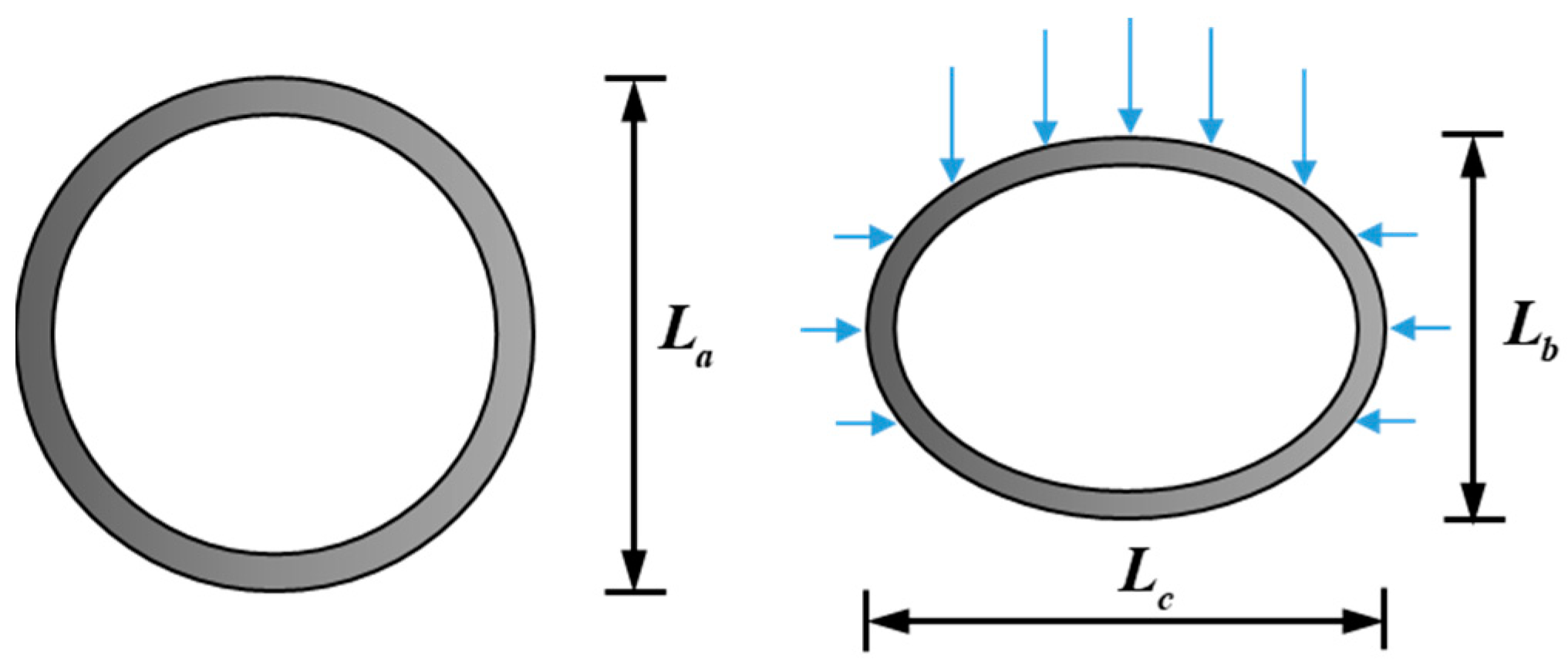
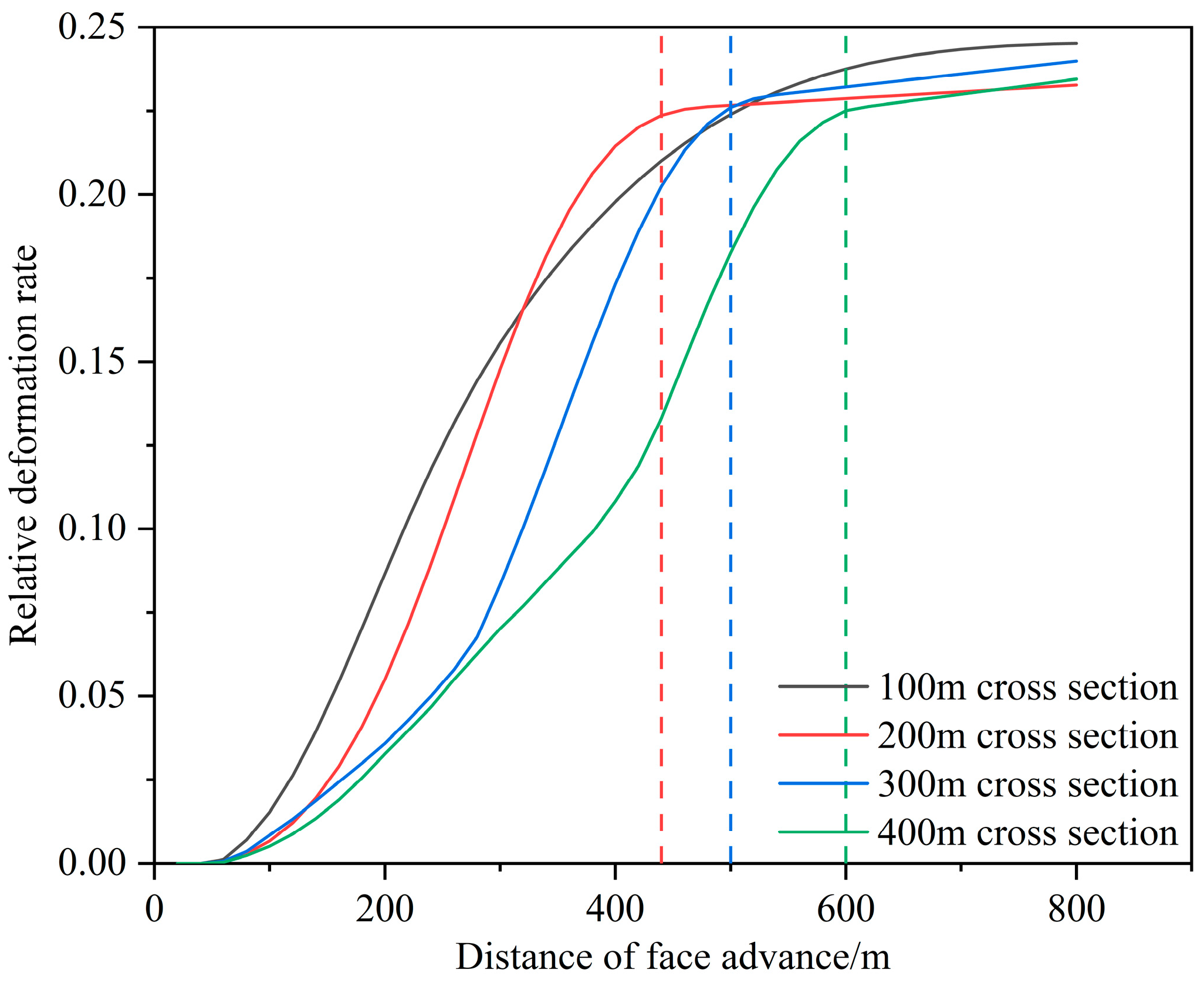
| Parameters | Value | Parameters | Value |
|---|---|---|---|
| D | 159 mm | 0.3 | |
| L | 900 m | t | 5 mm |
| FD | 0.9 | E | 2 × 105 MPa |
| SMYS | 450 MPa | 1.2 × 10−5 mm/(mm °C) | |
| p | 6.3 MPa | T1–T2 | 37° |
| Name of Material | Density (kg/m3) | Elastic Modulus (MPa) | Poisson Ratio | Cohesive Force (MPa) | Internal Friction Angle (°) |
|---|---|---|---|---|---|
| Aeolian sand | 1600 | 150 | 0.11 | 0.2 | 19 |
| Loess | 2100 | 525 | 0.32 | 0.8 | 30 |
| Red soil | 2260 | 500 | 0.31 | 2 | 34 |
| Mudstone | 2300 | 750 | 0.3 | 3.8 | 34 |
| Medium grained sandstone | 2360 | 900 | 0.34 | 4.4 | 36 |
| Coarse grained sandstone | 2340 | 1050 | 0.28 | 5.7 | 40 |
| Fine grained sandstone | 2450 | 1200 | 0.26 | 5.2 | 42 |
| Mudstone | 2300 | 750 | 0.3 | 3.8 | 34 |
| Siltstone | 2400 | 900 | 0.31 | 4.1 | 36 |
| Coal | 1350 | 300 | 0.2 | 0.4 | 29 |
| Siltstone | 2400 | 900 | 0.31 | 4.1 | 36 |
| Pipe | 7850 | 200,000 | 0.3 | / | / |
Disclaimer/Publisher’s Note: The statements, opinions and data contained in all publications are solely those of the individual author(s) and contributor(s) and not of MDPI and/or the editor(s). MDPI and/or the editor(s) disclaim responsibility for any injury to people or property resulting from any ideas, methods, instructions or products referred to in the content. |
© 2024 by the authors. Licensee MDPI, Basel, Switzerland. This article is an open access article distributed under the terms and conditions of the Creative Commons Attribution (CC BY) license (https://creativecommons.org/licenses/by/4.0/).
Share and Cite
Xu, Y.; Liang, S.; Liang, X.; Yang, B.; Shi, Z.; Wu, C.; Shen, J.; Yang, M.; Ma, Y.; Xu, P. Spatio-Temporal Evolution of Loading and Deformation of Surface Gas Pipelines for High-Intensity Coalbed Mining and Its Integrity Prediction Methodology. Processes 2024, 12, 213. https://doi.org/10.3390/pr12010213
Xu Y, Liang S, Liang X, Yang B, Shi Z, Wu C, Shen J, Yang M, Ma Y, Xu P. Spatio-Temporal Evolution of Loading and Deformation of Surface Gas Pipelines for High-Intensity Coalbed Mining and Its Integrity Prediction Methodology. Processes. 2024; 12(1):213. https://doi.org/10.3390/pr12010213
Chicago/Turabian StyleXu, Yingnan, Shun Liang, Xu Liang, Biao Yang, Zhuolin Shi, Chengle Wu, Jinhang Shen, Miao Yang, Yindou Ma, and Pei Xu. 2024. "Spatio-Temporal Evolution of Loading and Deformation of Surface Gas Pipelines for High-Intensity Coalbed Mining and Its Integrity Prediction Methodology" Processes 12, no. 1: 213. https://doi.org/10.3390/pr12010213
APA StyleXu, Y., Liang, S., Liang, X., Yang, B., Shi, Z., Wu, C., Shen, J., Yang, M., Ma, Y., & Xu, P. (2024). Spatio-Temporal Evolution of Loading and Deformation of Surface Gas Pipelines for High-Intensity Coalbed Mining and Its Integrity Prediction Methodology. Processes, 12(1), 213. https://doi.org/10.3390/pr12010213







